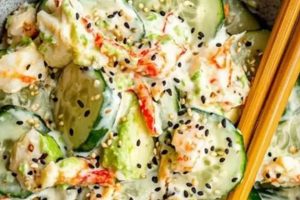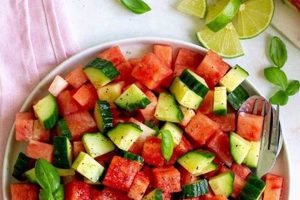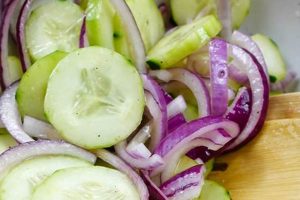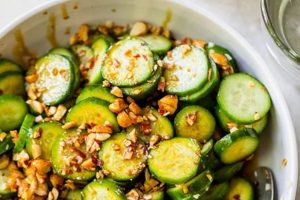A top-tier cucumber salad showcasing Japanese culinary principles typically features thinly sliced cucumbers dressed in a light, flavorful sauce. Common ingredients include rice vinegar, sesame oil, soy sauce, and mirin, often complemented by elements like toasted sesame seeds, chili flakes, or seaweed. Variations might incorporate ingredients like wakame seaweed, bonito flakes, or a touch of sugar or ginger.
The appeal of such a salad lies in its refreshing simplicity and balance of flavors. The crispness of the cucumber contrasts beautifully with the umami notes of the dressing, creating a dish that is both light and satisfying. This style of salad often accompanies richer Japanese meals, acting as a palate cleanser and offering a refreshing counterpoint. Its roots lie in the broader Japanese culinary tradition that values fresh, seasonal ingredients and harmonious flavor combinations. Such salads are common staples in Japanese homes and restaurants alike.
This exploration will delve deeper into specific ingredient choices, techniques for achieving optimal cucumber texture, and variations on the classic Japanese cucumber salad, offering readers a pathway to creating their own exceptional versions.
Tips for an Exceptional Japanese Cucumber Salad
Achieving a truly excellent cucumber salad hinges on attention to detail and an understanding of the interplay of flavors and textures. The following tips offer guidance for creating a dish that exemplifies Japanese culinary principles.
Tip 1: Salt and Drain the Cucumbers: Salting the thinly sliced cucumbers draws out excess moisture, preventing a watery salad and concentrating the cucumber flavor. After 15-20 minutes, gently squeeze out the released water.
Tip 2: Prioritize Quality Ingredients: Using high-quality rice vinegar, soy sauce, and sesame oil significantly impacts the final flavor profile. Freshly grated ginger, if used, offers a brighter, more vibrant taste.
Tip 3: Achieve Thin, Even Slices: Uniformly thin cucumber slices ensure even marinating and contribute to a pleasant textural experience. A mandoline slicer or sharp knife can achieve optimal results.
Tip 4: Balance the Dressing: The ideal dressing harmonizes sweet, salty, sour, and umami elements. Adjust the proportions of rice vinegar, soy sauce, mirin, and sugar to achieve the desired balance.
Tip 5: Toast Sesame Seeds: Toasting sesame seeds enhances their nutty flavor and aroma, adding depth to the salad. Toast lightly over medium heat until fragrant and golden brown.
Tip 6: Consider Adding Umami: A touch of dried bonito flakes or a small piece of kombu seaweed steeped in the rice vinegar can introduce subtle umami notes that elevate the complexity of the salad.
Tip 7: Chill Before Serving: Chilling allows the flavors to meld and enhances the refreshing qualities of the salad. Serve cold for the optimal experience.
By adhering to these guidelines, one can create a Japanese cucumber salad that is not only visually appealing but also delivers a delightful balance of flavors and textures. This approach ensures a dish that exemplifies the principles of Japanese cuisine: simplicity, freshness, and harmony.
With these tips in mind, the subsequent sections will explore specific recipe variations and address frequently asked questions.
1. Fresh, High-Quality Cucumbers
The foundation of a superlative Japanese cucumber salad rests upon the selection of fresh, high-quality cucumbers. These provide the crucial textural and flavor base upon which the other components build. Cucumbers lacking freshness or exhibiting bitterness detract significantly from the final dish. The ideal cucumber offers firm, crisp flesh with a mild, refreshing flavor. Common varieties like Japanese cucumbers, Persian cucumbers, or English cucumbers are well-suited for this purpose due to their thinner skins and less watery interiors. Selecting cucumbers with vibrant green skin, free from blemishes or soft spots, ensures optimal quality.
The impact of cucumber quality becomes evident upon tasting. A fresh cucumber, when thinly sliced, offers a satisfying crunch that contrasts beautifully with the softness of the seaweed and the tang of the dressing. Conversely, a less-than-fresh cucumber may have a mushy texture and a slightly bitter or off-putting flavor that compromises the overall balance of the salad. Consider the difference between a salad made with a crisp, freshly picked cucumber versus one made with a cucumber that has been sitting in the refrigerator for several days. The former delivers a vibrant, refreshing experience, while the latter may be disappointingly bland or even unpleasant.
Prioritizing cucumber selection directly correlates with the success of the dish. Subpar cucumbers cannot be masked, even by the most expertly crafted dressing. Therefore, procuring the freshest, highest-quality cucumbers available is paramount to achieving an exceptional Japanese cucumber salad. This foundational element sets the stage for a truly delightful culinary experience.
2. Balanced, Umami-Rich Dressing
A defining characteristic of the best Japanese cucumber salads lies in the delicate balance and umami richness of the dressing. The dressing is not merely a condiment; it is integral to the dish’s overall success, elevating the simple cucumbers to a new level of culinary sophistication. A well-crafted dressing harmonizes several key flavor profilessweet, sour, salty, and umamicreating a complex yet refreshing counterpoint to the crisp cucumber.
- Rice Vinegar: The Sour Foundation
Rice vinegar provides the foundational sourness, its mild acidity balancing the other flavors. Different varieties of rice vinegar offer subtle nuances; unseasoned rice vinegar offers a clean, pure sourness, while seasoned varieties incorporate a touch of sweetness and salt, streamlining the balancing process.
- Soy Sauce: Salt and Umami Depth
Soy sauce contributes saltiness and a significant portion of the umami character. The choice of soy sauce can influence the final taste; lighter soy sauces offer a more delicate flavor, while darker soy sauces provide a richer, more robust umami note. Tamari, a gluten-free alternative, can also be employed.
- Mirin and Sugar: Subtle Sweetness
Mirin, a sweet rice wine, adds a touch of sweetness and complexity. Alternatively, a small amount of granulated sugar can be used. This subtle sweetness rounds out the other flavors, preventing excessive sharpness from the vinegar and saltiness from the soy sauce.
- Sesame Oil: Nutty Aroma and richness
Sesame oil, typically toasted sesame oil, introduces a distinctive nutty aroma and a rich mouthfeel. Used sparingly, it enhances the overall sensory experience without overpowering the other components. Its unique flavor profile complements the cucumber and other dressing ingredients exceptionally well.
The interplay of these components is crucial. A dressing lacking sufficient acidity might taste flat, while an overabundance of soy sauce can make it overly salty. The delicate sweetness of mirin or sugar prevents the dressing from being too sharp, and the sesame oil adds a final layer of complexity. The ultimate goal is harmony, a balance where no single flavor dominates but rather contributes to a unified, delicious whole that perfectly complements the fresh, crisp cucumbers, resulting in a truly exceptional Japanese cucumber salad.
3. Thin, Consistent Cucumber Slices
Thin, consistent cucumber slices are integral to a superlative Japanese cucumber salad. This precise cutting technique affects several crucial aspects of the dish, impacting both flavor and texture. Uniformly thin slices ensure even marination, allowing the dressing to penetrate each piece thoroughly. This results in a harmonious blend of flavors, where the refreshing cucumber and the savory dressing complement each other perfectly. Conversely, unevenly sliced cucumbers lead to inconsistent flavor distribution, with some pieces absorbing more dressing than others, resulting in a less balanced and less satisfying culinary experience.
Beyond flavor, consistent slicing also influences texture. Thinly sliced cucumbers offer a delicate crunch that contrasts pleasantly with other components often included in the salad, such as seaweed or sesame seeds. Thicker slices, on the other hand, can be perceived as less refined and may lack the desired textural interplay. Consider the difference between biting into a thinly sliced cucumber, where the dressing clings delicately to the surface, and biting into a thick slice, where the center might remain undressed and watery. The former exemplifies the elegance and balance characteristic of Japanese cuisine, while the latter falls short of this ideal.
Achieving consistently thin slices requires attention to detail and appropriate tools. While a sharp knife can be employed effectively with practice, a mandoline slicer offers greater precision and efficiency, particularly for larger quantities. The investment in proper slicing techniques yields significant returns in the final dish, elevating the cucumber salad from simple to exceptional. This attention to detail exemplifies the core principles of Japanese culinary artistry, where precision and balance are paramount to achieving a truly delightful and harmonious culinary experience.
4. Proper Salting and Draining
Proper salting and draining of the cucumbers represents a crucial step in crafting a truly exceptional Japanese cucumber salad. This seemingly simple process significantly impacts the final dish’s texture, flavor, and overall balance. Neglecting this step can result in a watery salad with diluted flavors, undermining the careful balance of the dressing and diminishing the cucumbers’ crispness.
- Moisture Removal
Salting the thinly sliced cucumbers draws out excess moisture through osmosis. This process prevents the salad from becoming watery and concentrates the cucumber flavor, making it more pronounced. Without this step, the released moisture dilutes the dressing, leading to a less vibrant and less satisfying experience.
- Enhanced Texture
Removing excess moisture through salting contributes to a more desirable cucumber texture. By drawing out water, the cucumbers become slightly more firm and retain their crispness even after being dressed. This contrasts favorably with cucumbers that have not been salted, which can become limp and soggy, detracting from the overall textural experience.
- Improved Flavor Concentration
As moisture is drawn out, the cucumber flavor becomes more concentrated. This intensifies the refreshing cucumber taste, allowing it to stand up to the other flavors in the salad, particularly the umami-rich dressing. Salting essentially amplifies the inherent cucumber flavor, contributing to a more balanced and complex final dish.
- Enhanced Dressing Adherence
Salting and draining also improve the adherence of the dressing to the cucumbers. Excess moisture on the cucumber surface can prevent the dressing from clinging effectively. By removing this moisture, the dressing can coat the cucumber slices more evenly, ensuring a more consistent flavor distribution and preventing the pooling of dressing at the bottom of the bowl.
The process of salting and draining, while seemingly minor, plays a pivotal role in creating a Japanese cucumber salad that meets the highest standards of culinary excellence. It ensures the cucumbers remain crisp, prevents the dressing from becoming diluted, and intensifies the inherent cucumber flavor, thereby contributing significantly to the overall balance and harmony of the final dish. This attention to detail distinguishes a truly exceptional cucumber salad from a mediocre one.
5. Toasted Sesame Seeds
Toasted sesame seeds contribute significantly to what constitutes a “best Japanese cucumber salad recipe.” Their presence offers more than mere visual appeal; they provide a crucial textural and flavor dimension that elevates the dish. The toasting process unlocks a deeper, nuttier flavor profile absent in raw sesame seeds. This amplified nuttiness complements the refreshing cucumber and the savory-sweet notes of the typical dressing, adding a layer of complexity that distinguishes an exceptional salad.
Consider the textural contrast. The toasted sesame seeds introduce a delicate crunch that juxtaposes beautifully with the cool, crisp cucumber and the often-smooth dressing. This interplay of textures adds a dynamic element to each bite, making the eating experience more engaging. Furthermore, the slight bitterness inherent in toasted sesame seeds provides a subtle counterpoint to the other flavors, enhancing the overall balance. One can observe this effect by comparing a salad with toasted sesame seeds to one without; the former exhibits a more pronounced and nuanced flavor profile, while the latter may taste comparatively one-dimensional.
The practical significance of this understanding lies in the realization that even seemingly small details, such as toasting sesame seeds, play a vital role in achieving culinary excellence. The process itself is simple yet impactful. Lightly toasting the seeds in a dry pan until fragrant and golden brown maximizes their flavor contribution. Integrating this step into the recipe elevates the final product, demonstrating an attention to detail that characterizes a truly “best Japanese cucumber salad recipe.” Neglecting this seemingly minor detail can subtly yet noticeably detract from the overall experience, highlighting the importance of understanding the contribution of each ingredient.
6. Subtle Seasonings (Ginger, Chili)
While foundational elements like fresh cucumbers and a balanced dressing are essential, subtle seasonings distinguish exceptional Japanese cucumber salads. Judiciously employed, these seasonings add depth and complexity without overwhelming the delicate balance of flavors. Ginger and chili, commonly used in this context, offer distinct yet complementary contributions, enhancing both the aroma and taste of the salad.
- Ginger’s Bright, Pungent Note
Fresh ginger, grated finely or minced, introduces a bright, pungent note that cuts through the richness of the dressing and complements the cool cucumber. Its subtle heat adds a layer of complexity without overpowering the other flavors. A small amount suffices; too much ginger can dominate the flavor profile. The effect becomes evident in the immediate aroma and the lingering warmth on the palate, enhancing the refreshing qualities of the salad.
- Chili’s Gentle Heat
Chili, typically used sparingly in the form of flakes or a finely minced fresh chili, introduces a gentle heat that balances the cool cucumber and the tangy dressing. The type of chili used influences the intensity of the heat; milder varieties like Korean gochugaru offer a subtle warmth, while more potent chilies contribute a more pronounced spiciness. The goal is to enhance, not overwhelm, the other flavors. The judicious use of chili adds a pleasant tingling sensation without compromising the refreshing nature of the salad.
- Balancing Act: Harmony of Flavors
The success of using ginger and chili hinges on achieving balance. These seasonings should enhance, not dominate, the overall flavor profile. The quantity used depends on the desired level of intensity and the other ingredients in the salad. A delicate balance allows the refreshing cucumber flavor to shine through while adding subtle layers of complexity. Overuse can result in a salad that is too spicy or too ginger-forward, masking the delicate interplay of the other components.
- Cultural Context and Regional Variations
The use of ginger and chili reflects broader trends in Japanese cuisine, where subtle seasonings are employed to enhance the natural flavors of fresh ingredients. Regional variations exist, with some areas favoring a more pronounced use of chili or ginger. Understanding these nuances provides context and allows for greater appreciation of the diverse culinary landscape within Japan. This awareness also empowers individuals to tailor their salads to personal preferences, adjusting the seasonings to create a customized flavor experience.
The considered inclusion of these subtle seasonings distinguishes a truly exceptional Japanese cucumber salad. Ginger and chili, when used judiciously, elevate the dish beyond its simple components, adding layers of flavor and complexity that exemplify the principles of balance and harmony central to Japanese culinary artistry. These seemingly minor additions contribute significantly to the overall sensory experience, transforming a simple cucumber salad into a refined and memorable dish.
Frequently Asked Questions
This section addresses common inquiries regarding the preparation of exceptional Japanese cucumber salads, offering further clarity and guidance for achieving optimal results.
Question 1: What type of cucumber is best suited for this salad?
While various cucumber varieties can be used, Japanese cucumbers, Persian cucumbers, or English cucumbers are generally preferred due to their thinner skins, fewer seeds, and less watery flesh. These characteristics contribute to a crisper, more flavorful salad.
Question 2: Can the dressing be made ahead of time?
The dressing components can be combined in advance and stored separately. However, it is generally recommended to dress the cucumbers shortly before serving to maintain optimal texture and prevent them from becoming soggy.
Question 3: How long should the cucumbers be salted?
Salting time typically ranges from 15 to 20 minutes. This duration allows sufficient moisture release without excessively softening the cucumber slices. The cucumbers should then be gently squeezed to remove the extracted water.
Question 4: What can be added to the salad besides cucumbers?
Common additions include thinly sliced red onion, wakame seaweed, and toasted sesame seeds. Other options include a sprinkle of chili flakes for a touch of heat or a scattering of bonito flakes for added umami.
Question 5: How long can the salad be stored?
While best served immediately, the dressed salad can be stored in an airtight container in the refrigerator for up to 24 hours. However, some textural degradation may occur.
Question 6: Is it necessary to peel the cucumbers?
Peeling is generally not required, particularly for varieties like Japanese, Persian, or English cucumbers, as their skins are thin and tender. If using a cucumber with a thicker, tougher skin, peeling might be preferred for improved texture.
Understanding these nuances allows for greater control over the final product, facilitating the creation of a Japanese cucumber salad that aligns precisely with individual preferences and culinary aspirations. This attention to detail elevates the simple act of preparing a salad to an art form, yielding a dish that is both refreshing and deeply satisfying.
The subsequent section will offer a complete recipe, incorporating the insights and guidance provided throughout this exploration.
Best Japanese Cucumber Salad Recipe
Achieving a truly exceptional Japanese cucumber salad hinges on a nuanced understanding of ingredient selection, preparation techniques, and flavor balancing. From sourcing fresh, high-quality cucumbers to crafting a harmonious dressing and employing precise cutting techniques, each step contributes to the final product. Proper salting and draining, the inclusion of toasted sesame seeds, and the judicious use of subtle seasonings like ginger and chili further elevate the dish, adding layers of complexity and textural intrigue. Attention to these details distinguishes a simple cucumber salad from a culinary masterpiece.
The pursuit of the best Japanese cucumber salad recipe represents more than just a quest for a refreshing side dish. It embodies a deeper appreciation for the principles of Japanese cuisine: simplicity, freshness, and balance. By understanding and applying these principles, one can create a dish that is not only delicious but also reflects a mindful approach to cooking and eating. This culinary journey encourages exploration and adaptation, empowering individuals to refine their techniques and develop their own interpretations of this classic dish, continually striving for the perfect balance of flavors and textures.






